#European Retail Industry
Text
Changing Landscape of European Retail
Written By: Jagriti Shahi

Figure: Growth of retail in Europe
The retail industry in Europe has undergone significant transformations in recent years, driven by changing consumer preferences, technological advancements, and global economic shifts. From traditional brick-and-mortar stores to e-commerce giants, European retail has seen a remarkable evolution. In this article, we will explore the key trends shaping the changing landscape of European retail and how businesses are adapting to stay competitive in this dynamic environment. The retail sector in Europe is the largest in the world, with a turnover of over €2 trillion in 2021. The sector employs over 20 million people and accounts for about 10% of the EU's GDP. The retail sector in Europe is highly fragmented, with a large number of small and medium-sized enterprises (SMEs). However, there are also a number of large multinational retailers operating in the market, such as Carrefour, Tesco, and IKEA.

Figure: Growth of retail in Europe
The retail sector in Europe is facing a number of challenges, including the rise of e-commerce, the changing demographics of consumers, and the increasing adoption of new technologies. The rise of e-commerce is one of the most significant challenges facing the retail sector in Europe. In 2021, online retail sales in Europe reached €768 billion, accounting for 16.1% of total retail sales. This growth is being driven by a number of factors, including the increasing availability of high-speed internet, the growing popularity of mobile shopping, and the convenience of online shopping.
Traditional brick-and-mortar retailers are struggling to compete with the convenience and lower prices of online retailers. In order to survive, traditional retailers are investing in their online presence and offering omnichannel experiences that allow customers to shop online and in-store. The demographics of European consumers are also changing, which is having an impact on the retail landscape. The population is aging, with more people over the age of 65. This group is increasingly active and affluent, and they are looking for different products and services than younger consumers. They are also more likely to shop online.
Another demographic trend is the increasing diversity of the European population. This is leading to a demand for more ethnic food and clothing stores. Retailers are also adapting their marketing and advertising to reach these new customer groups.
New technologies are also having a major impact on the retail landscape. The use of artificial intelligence (AI), augmented reality (AR), and virtual reality (VR) is growing, and these technologies are being used to improve the customer experience in a number of ways. For example, AI can be used to personalize recommendations, AR can be used to try on clothes virtually, and VR can be used to create immersive shopping experiences. The adoption of new technologies is also creating new opportunities for retailers. For example, retailers can use data analytics to track customer behavior and improve their marketing and product offerings. They can also use social media to connect with customers and build relationships.
The future of European retail is uncertain, but it is clear that the industry is undergoing a major transformation. The rise of e-commerce, the changing demographics of consumers, and the increasing adoption of new technologies are all having a major impact on the way people shop. Retailers that are able to adapt to these changes will be the ones that are successful in the future.
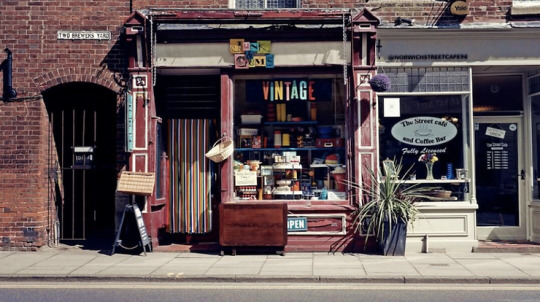
Figure: Brick-and-Mortar stores
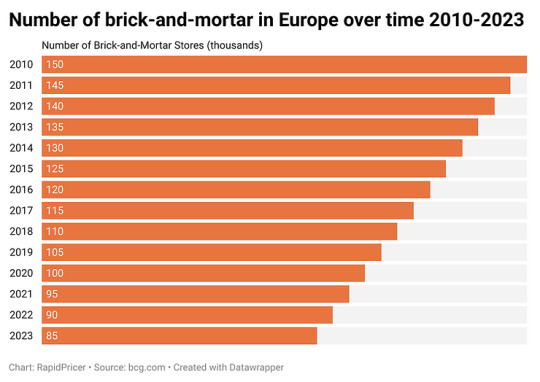
Figure: Number of brick-and-mortar in Europe over time

Figure: Department stores
Department stores: Department stores are large stores that sell a variety of products, such as clothing, home goods, and electronics. Some of the most famous department stores in Europe include Galeries Lafayette in Paris, Selfridges in London, and El Corte Inglés in Madrid.
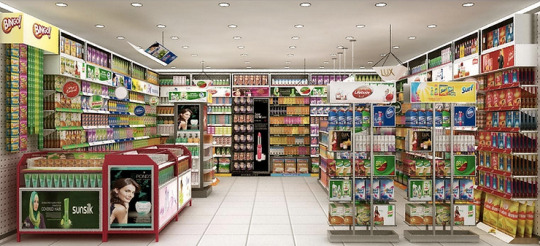
Figure: Independent retailers
Independent retailers: Independent retailers are small, privately owned businesses that sell a variety of products. These retailers often have a strong local presence and offer a unique shopping experience.
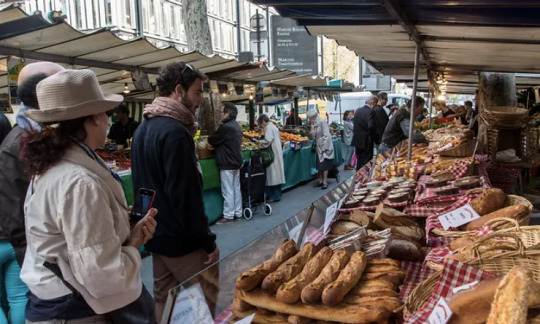
Figure: Markets
Markets: Markets are a great place to find fresh produce, meats, cheeses, and other local products. Many European cities have traditional markets that have been operating for centuries.

Figure: Outlet
Outlet malls: Outlet malls are a great place to find discounted name-brand clothing, shoes, and accessories. These malls are often located in tourist destinations.
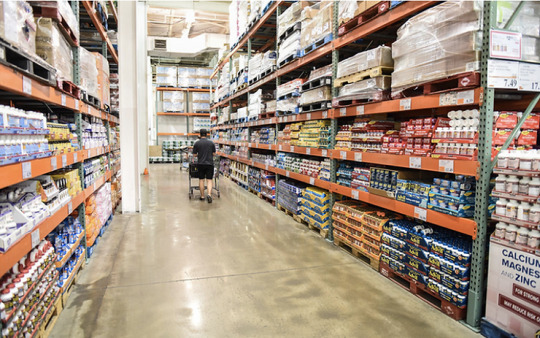
Figure: Warehouse clubs
Warehouse clubs: Warehouse clubs are membership-only stores that sell a variety of products in bulk. These clubs are a great place to find discounts on groceries, household goods, and other items.
Traditional retail is still a major part of the retail landscape in Europe, and it is likely to remain so for the foreseeable future. These stores offer a unique shopping experience that cannot be replicated online. In addition, many traditional retailers are adapting to the changing retail landscape by investing in their online presence and offering omnichannel shopping experiences.
The European Retail Landscape
Europe boasts a diverse and rich retail heritage, with traditional shops, boutiques, and markets dating back centuries. These establishments have played a significant role in local economies, offering consumers a wide range of goods and personalized shopping experiences.
Challenges in the Digital Age: Traditional retail in Europe has felt the impact of the digital age. The rapid growth of e-commerce giants like Amazon, along with the convenience of online shopping, has led to a decline in foot traffic at brick-and-mortar stores. Consumers now have access to a vast array of products with the click of a button, making it essential for traditional retailers to adapt.
The Omnichannel Approach: Many traditional European retailers are responding to the digital challenge by adopting an omnichannel approach. This strategy combines physical stores with an online presence, offering consumers a seamless shopping experience. Retailers are investing in e-commerce websites, mobile apps, and in-store technology to bridge the gap between offline and online shopping.
Customer Experience and Personalization: One advantage traditional retailers have over e-commerce is the ability to provide a unique and personalized customer experience. Many European consumers still value the tactile, sensory experience of shopping in a physical store. Traditional retailers are focusing on creating welcoming and interactive environments, offering personalized service, and curating their product selections to cater to local tastes.
Sustainability and Localism: In response to consumer demand for sustainability and ethical shopping, traditional European retailers are emphasizing their commitment to local sourcing and environmentally friendly practices. Some are rediscovering the benefits of locally-produced goods, promoting them as eco-friendly alternatives to mass-produced items. This aligns with the rising trend of supporting local businesses and reducing the carbon footprint associated with global supply chains.
Cultural and Historical Significance: Traditional retail establishments often hold cultural and historical significance in European communities. Many have been in operation for generations, serving as cornerstones of local culture. These stores are cherished by residents and tourists alike, and efforts are made to preserve their historical authenticity while integrating modern retail practices.
Government Support: Some European governments recognize the importance of preserving traditional retail and are offering support through grants, subsidies, and regulatory measures. These initiatives aim to bolster traditional retail against the encroachment of e-commerce and maintain the vibrancy of city centers.
Conclusion
Traditional retail in Europe is at a crossroads. While it faces challenges from the digital age and changing consumer preferences, it also has unique advantages rooted in history, culture, and personalized shopping experiences. To thrive in today's retail landscape, traditional retailers must embrace technology, adopt an omnichannel approach, focus on customer experience, and align with sustainability and localism trends. In doing so, traditional European retail can not only survive but also continue to offer consumers a distinctive and cherished shopping experience that reflects the rich tapestry of Europe's retail heritage. By adapting to the evolving market while preserving their unique qualities, traditional retailers can continue to play a vital role in the continent's commercial landscape.
The changing demographics of consumers
The demographics of European consumers are also changing, which is having an impact on the retail landscape. The population is aging, with more people over the age of 65. This group is increasingly active and affluent, and they are looking for different products and services than younger consumers. They are also more likely to shop online.
Another demographic trend is the increasing diversity of the European population. This is leading to a demand for more ethnic food and clothing stores. Retailers are also adapting their marketing and advertising to reach these new customer groups.
Here are some specific examples of how the changing demographics of consumers are impacting the retail industry in Europe:
The aging population is leading to a demand for more accessible and convenient shopping options. This is driving the growth of online grocery delivery and click-and-collect services.
The increasing diversity of the population is leading to a demand for more ethnic food and clothing stores. This is also leading to a demand for products and services that cater to the needs of diverse cultures, such as halal food and bilingual customer service.
The rise of the digital native is leading to a demand for more personalized and engaging shopping experiences. This is driving the growth of mobile commerce and augmented reality (AR) shopping.
The changing role of women is leading to a demand for more flexible shopping hours and options for online shopping. This is also leading to a demand for more products and services that are designed for women, such as maternity clothing and baby products.
The growing importance of sustainability is leading to a demand for more sustainable products and services. This is driving the growth of organic food, fair trade clothing, and recycled packaging.
The increasing adoption of new technologies
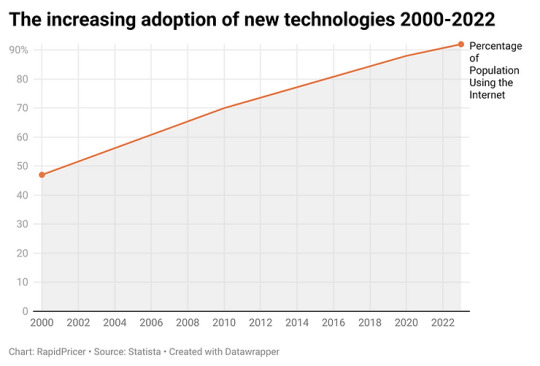
Figure: The increasing adoption of new technologies
As you can see, the percentage of people in Europe using the internet has been increasing steadily over the past two decades. This is due to a number of factors, including the increasing availability of high-speed internet, the falling cost of computers and smartphones, and the growing popularity of online services.
The increasing adoption of new technologies is having a major impact on the retail industry in Europe. Here are some of the key technologies that are being adopted by retailers in Europe:
Artificial intelligence (AI): AI is being used to improve a variety of tasks in the retail industry, such as customer service, inventory management, and fraud detection. For example, AI can be used to analyze customer data to personalize recommendations, or to predict which products are likely to be in high demand.
Augmented reality (AR): AR is being used to create immersive shopping experiences that allow customers to try on clothes virtually or see how furniture would look in their home. For example, IKEA has an AR app that allows customers to see how its furniture would look in their living room.
Virtual reality (VR): VR is being used to create even more immersive shopping experiences that allow customers to virtually visit stores and try on products. For example, Amazon has a VR store that allows customers to browse its products and make purchases.
Internet of Things (IoT): IoT is being used to connect devices and collect data about customer behavior. This data can be used to improve a variety of tasks, such as inventory management and customer service. For example, retailers can use IoT sensors to track the movement of products in stores and to identify when products are running low.
Blockchain: Blockchain is being used to create secure and transparent supply chains. This can help retailers to ensure the authenticity of their products and to track their products from the source to the customer. For example, Walmart is using blockchain to track the supply chain of its food products.
These are just some of the key technologies that are being adopted by retailers in Europe. The adoption of these technologies is helping retailers to improve their efficiency, personalize the customer experience, and create a more sustainable supply chain.
E-Commerce Dominance
One of the most profound shifts in European retail has been the rise of e-commerce. Consumers now have the convenience of shopping online from the comfort of their homes, and this trend has been accelerated by the COVID-19 pandemic. Major players like Amazon, Alibaba, and local champions such as Zalando and ASOS have expanded their reach across Europe, reshaping consumer behavior and expectations. Retailers have had to invest heavily in their online presence, enhancing websites, mobile apps, and supply chain logistics to meet the demand for digital shopping. Additionally, omnichannel strategies have become essential, allowing consumers to seamlessly switch between online and offline shopping experiences.
E-commerce dominance refers to the growing market share of online retailers over traditional brick-and-mortar stores. This trend is being driven by a number of factors, including the increasing availability of high-speed internet, the growing popularity of mobile shopping, and the convenience of online shopping. In Europe, e-commerce sales are expected to reach €768 billion in 2022, accounting for 16.1% of total retail sales. This growth is being driven by the increasing adoption of online shopping by consumers across all demographics.
There are a number of reasons why e-commerce is becoming so dominant. First, the availability of high-speed internet has made it possible for consumers to shop online quickly and easily. Second, the popularity of mobile shopping has made it possible for consumers to shop online from anywhere. Third, the convenience of online shopping is unmatched by traditional brick-and-mortar stores. Consumers can shop online 24/7, compare prices from different retailers, and have products delivered to their door. The rise of e-commerce is having a major impact on the retail industry. Traditional brick-and-mortar stores are facing increasing competition from online retailers, and many are struggling to compete. In order to survive, traditional retailers need to adapt to the changing retail landscape by investing in their online presence and offering omnichannel shopping experiences.

Figure: Share of online retail sales in Europe over time
As you can see, the share of online retail sales in Europe has been increasing steadily in recent years. This is due to the increasing popularity of online shopping, which is more convenient and offers a wider selection of products. The share of online retail sales is expected to continue to increase in the coming years. However, it is important to note that not all countries are affected equally. For example, the share of online retail sales is higher in Northern Europe than in Southern Europe. The future of online retail in Europe is bright. The growth of online shopping is being driven by a number of factors, including the increasing availability of high-speed internet, the growing popularity of smartphones and tablets, and the increasing convenience of online shopping.
Sustainability and Ethical Consumption
The European retail landscape is witnessing a significant shift towards sustainability and ethical consumption. Consumers are becoming increasingly aware of the environmental and social impact of their purchases. Retailers are responding by adopting eco-friendly practices, sourcing sustainable products, and promoting transparency in their supply chains.
Fashion brands, in particular, have made strides in sustainable fashion, with initiatives like "slow fashion" and clothing rental services gaining popularity. European consumers are favoring products that are produced responsibly and have a lower environmental footprint, and retailers are aligning their strategies with these values.
Personalization and Data Analytics
Data analytics and artificial intelligence are playing a crucial role in the transformation of European retail. Retailers are harnessing the power of big data to gain insights into consumer behavior, preferences, and shopping habits. This data-driven approach allows them to personalize marketing efforts, optimize inventory management, and enhance the overall shopping experience.
Personalized recommendations, targeted advertising, and tailored promotions are becoming the norm in the industry. Retailers are using predictive analytics to forecast trends and adjust their product offerings accordingly, ensuring they stay ahead of consumer demands.
Pop-Up Stores and Experiential Retail
While online shopping continues to grow, physical stores are not becoming obsolete. Instead, retailers are reimagining the in-store experience to attract and engage customers. Pop-up stores and experiential retail spaces are gaining popularity, offering unique and immersive experiences that cannot be replicated online.
These temporary stores allow retailers to test new products and connect with customers on a more personal level. They often incorporate interactive elements, such as virtual reality experiences or live demonstrations, to create memorable moments for shoppers.
Cross-Border Expansion
European retailers are increasingly looking beyond their home markets for growth opportunities. Cross-border expansion has become a viable strategy for many companies seeking to tap into new customer bases and diversify revenue streams. The European Union's single market has facilitated this expansion by reducing trade barriers and harmonizing regulations.
Furthermore, technology has made it easier for retailers to reach international customers through e-commerce platforms and digital marketing. As a result, many European brands are expanding their presence into neighboring countries and even outside of Europe, creating a more competitive and globalized retail landscape.
Post COVID European Retail
The retail industry in Europe is undergoing a period of change after COVID. The pandemic has accelerated the shift to online shopping, and brick-and-mortar stores are struggling to compete. Retailers are responding by adopting new technologies, such as AR and VR, and by offering more convenient shopping experiences, such as BOPIS. The industry is also focusing on sustainability, as consumers are increasingly demanding sustainable products and services.
Conclusion
The changing landscape of European retail is characterized by the rapid growth of e-commerce, a focus on sustainability and ethical consumption, data-driven personalization, experiential in-store experiences, and cross-border expansion. Retailers that adapt to these trends and embrace digital transformation are likely to thrive in this dynamic environment.
The future of European retail will continue to be shaped by evolving consumer preferences and technological innovations. To stay relevant, retailers must remain agile, customer-centric, and committed to ethical and sustainable practices. As the industry continues to evolve, it will be exciting to see how retailers innovate and compete in this ever-changing landscape.
About RapidPricer
RapidPricer helps automate pricing, promotions and assortment for retailers. The company has capabilities in retail pricing, artificial intelligence and deep learning to compute merchandising actions for real-time execution in a retail environment.
Contact info:
Website: https://www.rapidpricer.com/
LinkedIn: https://www.linkedin.com/company/rapidpricer/
Email: [email protected]
#European Retail Industry#Retail Trends in Europe#E-commerce Growth#Brick-and-Mortar Stores#Omnichannel Retailing#Digital Transformation#Consumer Behavior#Sustainability in Retail#Retail Technology#Online Marketplaces#Supply Chain Disruptions#Post-Pandemic Retail#Retail Innovation#Mobile Shopping#Data Analytics in Retail#Cross-Border Shopping#Pop-Up Stores#Customer Experience#Retail Competition#Retailer Partnerships#Retail Regulations#Future of Retail in Europe#Retail Challenges#Local vs. Global Retailers#Retail Adaptation Strategies
0 notes
Text
What Are The Major Factors Driving Retinal Biologics Market Growth?
The Retinal Biologics Market is experiencing a surge in demand, fueled by advancements in eye disease treatments and a growing emphasis on vision health. According to a recent analysis by Future Market Insights (FMI), a leading market research firm, the market is currently valued at an impressive US$22.25 billion in 2022. Looking ahead, the market is projected to witness a remarkable Compound Annual Growth Rate (CAGR) of 11.1% over the next six years. This translates to a staggering market valuation of US$41.92 billion by 2028, highlighting the significant potential of retinal biologics in revolutionizing eye care.The remarkable expansion of the Global Retinal Biologics sector is fueled by advancements in technology, innovative research, and a growing demand for cutting-edge treatments. As the industry continues to evolve, it presents unprecedented opportunities for stakeholders, investors, and healthcare professionals alike.Key Retinal Biologics Market Insights:
Rising Prevalence of Diabetes-related Eye Disorders and Age-related Macular Degeneration (AMD) The prevalence of diabetes-related eye disorders and age-related macular degeneration is on the rise, underscoring the growing need for innovative solutions within the Retinal Biologics Industry.Substantial Investment in R&D for Biologics in Retinal Disorders The industry is witnessing a significant influx of research and development resources, aimed at advancing biologics for both infectious and non-infectious retinal disorders. This investment underscores the commitment to addressing unmet medical needs.
Emergence of Specific Biologic Molecules as Therapeutic Targets Specific biologic molecules are gaining prominence as highly promising therapeutic targets, offering new hope for patients with retinal conditions.Gene Therapy as a Solution for Monogenic Retinal Illnesses With a growing number of monogenic retinal illnesses, gene therapy is emerging as a pivotal component of the Retinal Biologics Market, presenting innovative solutions for these challenging conditions.
Request a Sample Copy of This Report Now.https://www.futuremarketinsights.com/reports/sample/rep-gb-8663
#The Retinal Biologics Market is experiencing a surge in demand#fueled by advancements in eye disease treatments and a growing emphasis on vision health. According to a recent analysis by Future Market I#a leading market research firm#the market is currently valued at an impressive US$22.25 billion in 2022. Looking ahead#the market is projected to witness a remarkable Compound Annual Growth Rate (CAGR) of 11.1% over the next six years. This translates to a s#highlighting the significant potential of retinal biologics in revolutionizing eye care.The remarkable expansion of the Global Retinal Biol#innovative research#and a growing demand for cutting-edge treatments. As the industry continues to evolve#it presents unprecedented opportunities for stakeholders#investors#and healthcare professionals alike.Key Retinal Biologics Market Insights:Rising Prevalence of Diabetes-related Eye Disorders and Age-relate#underscoring the growing need for innovative solutions within the Retinal Biologics Industry.Substantial Investment in R&D for Biologics in#aimed at advancing biologics for both infectious and non-infectious retinal disorders. This investment underscores the commitment to addres#offering new hope for patients with retinal conditions.Gene Therapy as a Solution for Monogenic Retinal Illnesses With a growing number of#gene therapy is emerging as a pivotal component of the Retinal Biologics Market#presenting innovative solutions for these challenging conditions.Request a Sample Copy of This Report Now.https://www.futuremarketinsights.#institutional sales in the Retinal Biologics Industry#where Retinal Biologics are supplied in speciality clinics and hospitals#will generate higher revenues. In 2018#hospital sales accounted for more than 35% of market revenue.According to the report#retail sales of Retinal Biologics will generate comparable revenues to hospital sales and will expand at an 11.9% annual rate in 2019. Reta#with retail pharmacies generating more money than their counterparts in the future years.Penetration in North America Higher#APEJ’s Attractiveness to IncreaseNorth America continues to be the market leader in Retinal Biologics revenue. According to FMI estimates#North America accounted for more than 46% of global Retinal Biologics Industry revenues in 2018. Revenues in North America are predicted to#continuous growth in the healthcare infrastructure#and a favourable reimbursement scenario.Europe accounted for about one-fourth of the Retinal Biologics market#with Western European countries such as Germany#the United Kingdom#France#Italy
1 note
·
View note
Text
Wine Woman Whisky Whisperer

Website: https://www.winewomanww.com
Wine Woman Whisky Whisperer specializes in importing exclusive, organic European wines and Japanese whisky. With a focus on eco-friendly and sustainable practices, they offer a unique collection of wines and spirits, alongside private label wines for wholesale. Their services extend to private tastings, degustation events, and hospitality training, emphasizing their commitment to quality and environmental sustainability.
Facebook: https://www.facebook.com/Winewomanww
Instagram: https://www.instagram.com/winewomanwhiskywhisperer/
Keywords:
Japanese distilleries
Hospitality industry training
Wine tasting events
Degustation experience
Australian wine market
Biodynamic wines online
Sustainable wineries
Australian wine market trends
Biodynamic wines for sale
Eco-friendly spirits
European vineyards
Organic wine sales
Private label wine services
Sustainable winemaking practices
Wine event management
Wine event planning
eco friendly spirits
european wine importers
japanese whisky retailers
wholesale wine distribution
sustainable liquor practices
unique wine collection
quality spirits import
wine and whisky expertise
whisky tasting sessions
organic wine varieties
biodynamic wine options
sustainable spirit choices
eco conscious winemaking
imported european wines
authentic japanese whisky
custom label wine services
bulk wine distribution
engaging wine tastings
exquisite degustation experiences
training for hospitality professionals
sustainability in liquor production
rare and unique wine finds
premium spirits imports
wine and whisky connoisseurship
old world charm of european vineyards
japanese artistry in distilleries
wine event coordination
whisky tasting workshops
certified organic wine sales
environmentally friendly spirits
sustainable practices in winemaking
exclusive european wine imports
sought after japanese whiskies
custom branded wine options
wine distribution for businesses
interactive wine tastings
fine degustation experiences
professional training for hospitality
sustainability initiatives in liquor
collectible and unique wines
importing high quality spirits
expertise in wine and whisky
australian wine market insights
exploring european vineyard landscapes
japanese craftsmanship in distilling
whisky tasting masterclasses
organic wine sales online
biodynamic wine selections
eco friendly spirit choices
premier european wine imports
rare japanese whisky finds
private label wine customization
wholesale wine distribution services
exclusive wine tasting experiences
degustation events for enthusiasts
advanced hospitality industry training
liquor sustainability education
limited edition and unique wines
premium imported spirits
wine and whisky aficionado expertise
australian wine market developments
european vineyard terroir
japanese whisky distillation art
wine event coordination services
whisky tasting seminars
certified organic wine selections
biodynamic wines with character
eco conscious spirit offerings
sustainability in artisanal winemaking
european wine import insights
japanese whisky culture appreciation
custom label wine services for businesses
wine distribution partnerships
immersive wine tasting experiences
degustation events for connoisseurs
#Japanese distilleries#Hospitality industry training#Wine tasting events#Degustation experience#Australian wine market#Biodynamic wines online#Sustainable wineries#Australian wine market trends#Biodynamic wines for sale#Eco-friendly spirits#European vineyards#Organic wine sales#Private label wine services#Sustainable winemaking practices#Wine event management#Wine event planning#eco friendly spirits#european wine importers#japanese whisky retailers#wholesale wine distribution#sustainable liquor practices#unique wine collection#quality spirits import#wine and whisky expertise#whisky tasting sessions#organic wine varieties#biodynamic wine options#sustainable spirit choices#eco conscious winemaking#imported european wines
1 note
·
View note
Text
The local population in countries that export bananas typically eat different varieties grown primarily by small farmers. The ones for the Americans and the Europeans, Cavendish variety bananas, are grown in huge, monoculture plantations that are susceptible to disease. The banana industry consumes more agrichemicals than any other in the world, asides from cotton. Most plantations will spend more on pesticides than on wages. Pesticides are sprayed by plane, 85% of which does not land on the bananas and instead lands on the homes of workers in the surrounding area and seeps into the groundwater. The results are cancers, stillbirths, and dead rivers.
The supermarkets dominate the banana trade and force the price of bananas down. Plantations resolve this issue by intensifying and degrading working conditions. Banana workers will work for up to 14 hours a day in tropical heat, without overtime pay, for 6 days a week. Their wages will not cover their cost of housing, food, and education for their children. On most plantations independent trade unions are, of course, suppressed. Contracts are insecure, or workers are hired through intermediaries, and troublemakers are not invited back.
Who benefits most from this arrangement? The export value of bananas is worth $8bn - the retail value of these bananas is worth $25bn. Here's a breakdown of who gets what from the sale of banana in the EU.
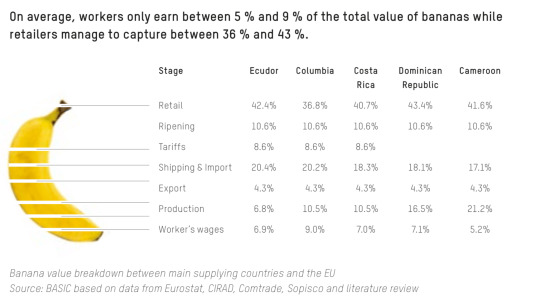
On average, the banana workers get between 5 and 9% of the total value, while the retailers capture between 36 to 43% of the value. So if you got a bunch of bananas at Tesco (the majority of UK bananas come from Costa Rica) for 95p, 6.65p would go to the banana workers, and 38p would go to Tesco.
Furthermore, when it comes to calculating a country's GDP (the total sum of the value of economic activity going on in a country, which is used to measure how rich or poor a country is, how fast its economy is 'growing' and therefore how valuable their currency is on the world market, how valuable its government bonds, its claim on resources internationally…etc), the worker wages, production, export numbers count towards the country producing the banana, while retail, ripening, tariffs, and shipping & import will count towards the importing country. A country like Costa Rica will participate has to participate in this arrangement as it needs ‘hard’ (i.e. Western) currencies in order to import essential commodities on the world market.
So for the example above of a bunch of Costa Rican bananas sold in a UK supermarket, 20.7p will be added to Costa Rica’s GDP while 74.3p will be added to the UK’s GDP. Therefore, the consumption of a banana in the UK will add more to the UK’s wealth than growing it will to Costa Rica’s. The same holds for Bangladeshi t-shirts, iPhones assembled in China, chocolate made with cocoa from Ghana…it’s the heart of how the capitalism of the ‘developed’ economy functions. Never ending consumption to fuel the appearance of wealth, fuelled by the exploitation of both land and people in the global south.
7K notes
·
View notes
Text


LEICA AND THE JEWS
The Leica is the pioneer 35mm camera. It is a German product - precise, minimalist, and utterly efficient.
Behind its worldwide acceptance as a creative tool was a family-owned, socially oriented firm that, during the Nazi era, acted with uncommon grace, generosity and modesty. E. Leitz Inc., designer and manufacturer of Germany's most famous photographic product, saved its Jews.
And Ernst Leitz II, the steely-eyed Protestant patriarch who headed the closely held firm as the Holocaust loomed across Europe , acted in such a way as to earn the title, "the photography industry's Schindler."
As soon as Adolf Hitler was named chancellor of Germany in 1933, Ernst Leitz II began receiving frantic calls from Jewish associates, asking for his help in getting them and their families out of the country. As Christians, Leitz and his family were immune to Nazi Germany's Nuremberg laws, which restricted the movement of Jews and limited their professional activities.
To help his Jewish workers and colleagues, Leitz quietly established what has become known among historians of the Holocaust as "the Leica Freedom Train," a covert means of allowing Jews to leave Germany in the guise of Leitz employees being assigned overseas.
Employees, retailers, family members, even friends of family members were "assigned" to Leitz sales offices in France, Britain, Hong Kong and the United States, Leitz's activities intensified after the Kristallnacht of November 1938, during which synagogues and Jewish shops were burned across Germany.
Before long, German "employees" were disembarking from the ocean liner Bremen at a New York pier and making their way to the Manhattan office of Leitz Inc., where executives quickly found them jobs in the photographic industry.
Each new arrival had around his or her neck the symbol of freedom - a new Leica camera.
The refugees were paid a stipend until they could find work. Out of this migration came designers, repair technicians, salespeople, marketers and writers for the photographic press.
Keeping the story quiet The "Leica Freedom Train" was at its height in 1938 and early 1939, delivering groups of refugees to New York every few weeks. Then, with the invasion of Poland on Sept. 1, 1939, Germany closed its borders.
By that time, hundreds of endangered Jews had escaped to America, thanks to the Leitzes' efforts. How did Ernst Leitz II and his staff get away with it?
Leitz, Inc. was an internationally recognized brand that reflected
credit on the newly resurgent Reich. The company produced cameras, range-finders and other optical systems for the German military. Also, the Nazi government desperately needed hard currency from abroad, and Leitz's single biggest market for optical goods was the United States.
Even so, members of the Leitz family and firm suffered for their good works. A top executive, Alfred Turk, was jailed for working to help Jews and freed only after the payment of a large bribe.
Leitz's daughter, Elsie Kuhn-Leitz, was imprisoned by the Gestapo after she was caught at the border, helping Jewish women cross into Switzerland . She eventually was freed but endured rough treatment in the course of questioning. She also fell under suspicion when she attempted to improve the living conditions of 700 to 800 Ukrainian slave laborers, all of them women, who had been assigned to work in the plant during the 1940s.
(After the war, Kuhn-Leitz received numerous honors for her humanitarian efforts, among them the Officier d'honneur des Palms Academic from France in 1965 and the Aristide Briand Medal from the European Academy in the 1970s.)
Why has no one told this story until now? According to the late Norman Lipton, a freelance writer and editor, the Leitz family wanted no publicity for its heroic efforts. Only after the last member of the Leitz family was dead did the "Leica Freedom Train" finally come to light.
It is now the subject of a book, "The Greatest Invention of the Leitz Family: The Leica Freedom Train," by Frank Dabba Smith, a California-born Rabbi currently living in England.
Thank you for reading the above, and if you feel inclined as I did to pass it along to others, please do so. It only takes a few minutes.
Memories of the righteous should live on.
Rabbi Yisroel Bernath
44 notes
·
View notes
Text
[T]he Dutch Republic, like its successor the Kingdom of the Netherlands, [...] throughout the early modern period had an advanced maritime [trading, exports] and (financial) service [banking, insurance] sector. Moreover, Dutch involvement in Atlantic slavery stretched over two and a half centuries. [...] Carefully estimating the scope of all the activities involved in moving, processing and retailing the goods derived from the forced labour performed by the enslaved in the Atlantic world [...] [shows] more clearly in what ways the gains from slavery percolated through the Dutch economy. [...] [This web] connected them [...] to the enslaved in Suriname and other Dutch colonies, as well as in non-Dutch colonies such as Saint Domingue [Haiti], which was one of the main suppliers of slave-produced goods to the Dutch economy until the enslaved revolted in 1791 and brought an end to the trade. [...] A significant part of the eighteenth-century Dutch elite was actively engaged in financing, insuring, organising and enabling the slave system, and drew much wealth from it. [...] [A] staggering 19% (expressed in value) of the Dutch Republic's trade in 1770 consisted of Atlantic slave-produced goods such as sugar, coffee, or indigo [...].
---
One point that deserves considerable emphasis is that [this slave-based Dutch wealth] [...] did not just depend on the increasing output of the Dutch Atlantic slave colonies. By 1770, the Dutch imported over fl.8 million worth of sugar and coffee from French ports. [...] [T]hese [...] routes successfully linked the Dutch trade sector to the massive expansion of slavery in Saint Domingue [the French colony of Haiti], which continued until the early 1790s when the revolution of the enslaved on the French part of that island ended slavery.
Before that time, Dutch sugar mills processed tens of millions of pounds of sugar from the French Caribbean, which were then exported over the Rhine and through the Sound to the German and Eastern European ‘slavery hinterlands’.
---
Coffee and indigo flowed through the Dutch Republic via the same trans-imperial routes, while the Dutch also imported tobacco produced by slaves in the British colonies, [and] gold and tobacco produced [by slaves] in Brazil [...]. The value of all the different components of slave-based trade combined amounted to a sum of fl.57.3 million, more than 23% of all the Dutch trade in 1770. [...] However, trade statistics alone cannot answer the question about the weight of this sector within the economy. [...] 1770 was a peak year for the issuing of new plantation loans [...] [T]he main processing industry that was fully based on slave-produced goods was the Holland-based sugar industry [...]. It has been estimated that in 1770 Amsterdam alone housed 110 refineries, out of a total of 150 refineries in the province of Holland. These processed approximately 50 million pounds of raw sugar per year, employing over 4,000 workers. [...] [I]n the four decades from 1738 to 1779, the slave-based contribution to GDP alone grew by fl.20.5 million, thus contributing almost 40% of all growth generated in the economy of Holland in this period. [...]
---
These [slave-based Dutch commodity] chains ran from [the plantation itself, through maritime trade, through commodity processing sites like sugar refineries, through export of these goods] [...] and from there to European metropoles and hinterlands that in the eighteenth century became mass consumers of slave-produced goods such as sugar and coffee. These chains tied the Dutch economy to slave-based production in Suriname and other Dutch colonies, but also to the plantation complexes of other European powers, most crucially the French in Saint Domingue [Haiti], as the Dutch became major importers and processers of French coffee and sugar that they then redistributed to Northern and Central Europe. [...]
The explosive growth of production on slave plantations in the Dutch Guianas, combined with the international boom in coffee and sugar consumption, ensured that consistently high proportions (19% in 1770) of commodities entering and exiting Dutch harbors were produced on Atlantic slave plantations. [...] The Dutch economy profited from this Atlantic boom both as direct supplier of slave-produced goods [from slave plantations in the Dutch Guianas, from Dutch processing of sugar from slave plantations in French Haiti] and as intermediary [physically exporting sugar and coffee] between the Atlantic slave complexes of other European powers and the Northern and Central European hinterland.
---
Text above by: Pepijn Brandon and Ulbe Bosma. "Slavery and the Dutch economy, 1750-1800". Slavery & Abolition Volume 42, Issue 1. 2021. [Text within brackets added by me for clarity. Bold emphasis and some paragraph breaks/contractions added by me. Presented here for commentary, teaching, criticism purposes.]
#abolition#these authors lead by pointing out there is general lack of discussion on which metrics or data to use to demonstrate#extent of slaverys contribution to dutch metropolitan wealth when compared to extensive research#on how british slavery profits established infrastructure textiles banking and industrialisation at home domestically in england#so that rather than only considering direct blatant dutch slavery in guiana caribbean etc must also look at metropolitan business in europe#in this same issue another similar article looks at specifically dutch exporting of slave based coffee#and the previously unheralded importance of the dutch export businesses to establishing coffee mass consumption in europe#via shipment to germany#which ties the expansion of french haiti slavery to dutch businesses acting as intermediary by popularizing coffee in europe#which invokes the concept mentioned here as slavery hinterlands#and this just atlantic lets not forget dutch wealth from east india company and cinnamon and srilanka etc#and then in following decades the immense dutch wealth and power in java#tidalectics#caribbean#archipelagic thinking#carceral geography#ecologies#intimacies of four continents#indigenous#sacrifice zones#slavery hinterlands#european coffee
25 notes
·
View notes
Text
Traditionally incoming Argentinian presidents give an inauguration speech inside of Congress to other politicians. Javier Milei, a former “tantric sex instructor” turned libertarian economist, symbolically gave his speech with his back to the Congress facing towards the people.
“For more than 100 years, politicians have insisted on defending a model that only produces poverty, stagnation, and misery,” President Milei said. “A model that assumes that citizens exist to serve politics, not that politics exists to serve citizens.” He also promised an “end a long and sad history of decadence and decline” and promote a new era based on peace, prosperity, and freedom.
Since his headline-making election victory last month, media portrayal of Milei has ranged from dismissive to condescending, often depicting him as an eccentric “far-right populist.” Yet, since taking office, Milei has shelved many of his campaign’s more contentious proposals and begun implementing a radical but, by international standards, orthodox reform plan to revitalize Argentina’s faltering economy.
Milei inherited a challenging situation. Argentina’s economy has shrunk by 12 per cent over the last decade, annual inflation reached an extraordinary 160 per cent in November, while the poverty rate increased to 40 per cent in the first half of 2023.
Argentina has a fascinating economic history that led up to this point. In the 19th century post-independence Argentina adopted a liberal constitution that helped deliver an impressive economic expansion.
By the early 20th century, Argentina was one of the world’s richest countries, driven by agricultural exports. Real wages were comparable to Britain and only slightly below the United States. Millions fled destitution in southern Europe for a new life in Argentina. Buenos Aires has been labelled the “Paris of South America” because of spectacular neoclassical architecture built during this era.
This turned to disaster over the subsequent decades because of collectivist rule – from military dictatorships to avidly socialist leaders. Argentina nationalised industries, subsidised domestic production, limited external trade, and introduced an unaffordable welfare state. This has become known as the Peronism, named after 20th century president Juan Domingo Perón, a leftist populist leader who supressed opposition and controlled the press.
This agenda accelerated in recent decades under self-identifying Peronist leaders, turning Argentina into one of the world’s most closed and heavily regulated countries. The latest Human Freedom Index places Argentina at 163rd in the world for openness to trade and 143rd for regulatory burden. This has culminated in an economy on the precipice of economic disaster.
Not wasting any time, Milei has proposed a mega package of over 350 economic reforms to open the economy and remove regulatory barriers. This includes privatising inefficient state assets, eliminating rent controls and restrictive retail regulations, liberalising labour laws, lifting export prohibitions, and allowing contracts in foreign currencies.
There has been a notable absence of some of most radical ideas – such as legalising organ sales or banning abortion. He has also put on hold plans to dollarise the economy and abolish the central bank. Instead, at least by international standards, the agenda contains several orthodox economic reforms.
Many of the measures – such as cutting spending to get the deficit (currently at 15 per cent of GDP) under control, opening the country up to international trade, and liberalising the airline industry through ‘open skies’ policy – would be required to join the European Union. The government is eliminating capital and currency controls and allowing the peso to devalue – measures that the IMF’s managing director Kristina Georgieva said these are important to stabilise the economy.
There are undoubtedly significant challenges ahead and some darker elements to agenda.
Milei has been, uncharacteristically for a politician, honest that “in the short term the situation will get worse”. The removal of price controls, for example, will increase inflation until demand and supply can stabilise to end shortages. But, he says, “then we will see the fruits of our efforts, having created the foundations of a solid and sustainable growth over time.”
The government is facing significant opposition, with the union movement organising mass protests and threatening a general strike. The government has responded by proposing questionable new anti-protest laws, that include lengthy jail sentences for road-blocking and requirements to seek permission for gatherings of more than three people in a public place. Milei, who could struggle to get much of his agenda through Argentina’s Congress, is asking for sweeping emergency presidential powers until the end of 2025. This raises serious questions about democratic accountability.
Nevertheless, there are some positive early signs. Since Milei’s election Argentina’s flagship stock index has risen by almost one-third and the peso’s value has not collapsed. Argentina could soon benefit from a major new shale pipeline pumping one million barrels of crude a day (helped along by reforms that allow exports of oil and sales at market prices) and the mining of the second largest proven lithium reserves in the world.
Argentina has long served as a solemn reminder that prosperity is neither inevitable nor unassailable. Misguided policies can transform mere challenges into a profound crisis. Milei is offering a glimmer of hope: redemption may just be possible. Let’s also hope that Britain’s leaders can similarly take the path of reform, ideally before things get as bad as Argentina.
Matthew Lesh is the Director of Public Policy and Communications at the Institute of Economic Affairs
11 notes
·
View notes
Text
International Taxes
Ko-Fi prompt from Ethan:
All I know about tariffs is that they're special taxes for international trade but people talk about them all the time. Please help explain
So we are going to talk about three things here:
Tariffs
VAT
Customs/Duties
I'll be using the US for most of my examples, because that's what I know best... and also because it's a very convenient example for the way VAT works on an international level.
Tariffs
You are correct that tariffs are special taxes for international trade. These are essentially fees that are applied to products being shipped in and out of a country in order to promote domestic product or impact a foreign one.
A common example is US steel. The United States has a fairly robust steel industry, and the government promotes that industry domestically by applying tariffs to imports. Back in 2018, Trump imposed a 25% tariff on steel imports and 10% on aluminum (something that the WTO said was illegal, but that's not relevant right now). The steel tariff had previously been a range of 8-30%, implemented by Bush in 2002. Prior to that, the steel tariff had generally been under 1%.
In applying that tariff, the federal government prioritized domestic purchasing. If domestic product is nominally $90 for one unit, and foreign product is $80, then it is cheaper and more appealing to buy from a foreign producer. With a 25% tariff, the foreign product is now functionally $100 per unit, making it more appealing to buy domestically. While the actual cost of the tax is born by the producing country, in the case of import tariffs, the result is the raising of costs when selling internationally.
Tariffs are also applied to specific countries. Once again using a Trump example, a $50 billion tariff was applied against China in 2018. This had negative impacts on the economy, as it led to worries of a trade war; China did retaliate by applying tariffs directly to specific products from the US, including wine and pork.
High tariffs theoretically lead to an increase in domestic trade, but they also lead to higher rates of smuggling. They are also a form protectionist policy, which was at its height in the 19th century for the US.
VAT - Value Added Tax
If you look up VAT, you get a lot of explanations that talk about how it is a tax that is levied against the consumer on the basis of the cumulative value of the product, and generally things are confusingly worded, so I'll save you some time:
It's sales tax.
If you are American like me, that's all it is. It's a different name for sales tax.
You get something for $8 at the store, but the final cost is $8.42? Those 42 cents are the VAT.
What does that have to do with international trade? Isn't that a domestic thing?
Well, yes and no. We'll start by comparing the US to most European countries.
See, the US has a different application of VAT than a lot of other places. In the US, sales tax is added at the very end of a purchase for the vast majority of places. This is because there is no federal sales tax. Instead, taxes are set by the state, county, and city governments. Take a look at this map of New York, and you'll see how much sales tax varies by just a few miles.
Given how much a pricing can vary from one town to the next, large corporations generate a greater profit by listing prices in their pre-tax form, and then adding that tax at the end. The consumer knows that there will be a higher price at the counter than is listed, because the standard in the US is to not include that tax. So your Arizona Iced Tea will be a $1 in Portland and $1 in Queens County, matching that promise on the can... but you'll still be paying $1 in Portland and $1.09 in Queens, because only one of those areas has sales tax, despite both being in the same country.
This works out for the retailer, because the consumer does not blame them for raising prices across county lines, if there is a sales tax hike. The thought of "it's cheaper ten miles down the road, I'll get to it later," followed by never getting to it and thus never making a purchase, is rarer, because the listed price is still the same. It also means having to print or design fewer price tags; imagine having to manually change every price in a supermarket magazine! Every coupon needs to have its price changed by a few cents, to account for tax!
...or you can just print the same magazine with the same prices and write "plus tax" after the listed cost.
All this to say, Americans are used to adding sales tax at the end, and knowing that the price they see is not the price they'll pay.
Other countries Do Not Do This.
I mean, some do. But we're talking about the ones that don't, which includes the entirety of the EU, India, some of Japan, and the country I actually have extensive experience with: Serbia.
I am currently in Serbia, which means I'm in a country with a sales tax/VAT that is higher than I'm used to (20% on most goods, 8% on essentials). In every store I've been to, the tax is included in the listed price. If it says 87 rsd on a carton of milk, I will be paying 87 rsd at checkout. The baseline price is 80 rsd, and then there's the 8% tax, and the final price is 86.4, which gets rounded up to the 87 that is listed on the tag.
If you aren't accustomed to thinking about VAT like in the US, online shopping can be... a trial.
If I purchase something from, say, Canada, and have it mailed to the US, I am given the sales tax as part of the purchasing process. It will format the receipt as the product plus sales tax. This is familiar to me.
To someone from the EU who does not purchase internationally (specifically from the US, Canada, or other countries that don't include sales tax in the sticker price), this tax can often come as a surprise.
And, finally, in some cases... the will be paid at the very end, at the point of pickup, along with customs. I recently purchased something from an English creator that was manufactured in Germany and then shipped to Serbia. I anticipated that I had paid the VAT for Serbia when purchasing the product. It was instead added at the point of purchase, as Serbia is neither in the EU nor in a trade agreement with the relevant countries that would allow for me to pay the VAT online, I had to pay the 20% in addition to customs when picking up the package from the postal office.
Despite not being a tariff or customs/duty payment, VAT can have a direct impact on international purchasing.
Customs/Duties
Customs and duties are taxes applied to products based on those product characteristics.
There is overlap with tariffs. As a consumer, you are... not going to be very affected by the difference between customs and tariffs.
Customs are like VAT, in that they are paid by the consumer rather than by the manufacturer.
You can think of tariffs as a fee that a manufacturer pays to sell something internationally (though that cost is often passed on to the consumer), and customs as a fee paid by a consumer to receive that good.
Hope this helps!
(And if anyone here is more familiar with the subject than I am, please feel free to add on or correct me! I'm generally pretty good about international policy, but I'm not an expert, and this subject can be a complicated one.)
(Prompt me on ko-fi!)
#taxes#tariffs#taxation#customs#duties#sales tax#vat#phoenix posts#ko fi#ko fi prompts#economics#ko-fi#economics prompts
98 notes
·
View notes
Text
Hottest trend in European Startups: Innovating ways to flavour water without having to pay for a soda or a bottle

Located in Switzerland, Dropz creates small aroma pearls from pressed fruits and herbs that transform ordinary water into a flavourful beverage, promoting sustainability and reducing bottled drink consumption. They support PET recycling and provide starter sets with various flavours and reusable bottles. Founded in 2020, Dropz has raised almost €2.5 million, aiming to make tap water appealing without sacrificing taste.

This fast-growing hydration brand, based in Vienna, Austria, disrupts the beverage industry with its innovative waterdrop® Microdrink and global hydration platform. Their mission is to encourage people to drink more water sustainably, with sugar-free, flavoured cubes that dissolve in water. They offer a range of dissolvable cubes, including flavoured Microdrinks, instant Microtea, caffeinated Microenergy, and rehydrating Microlyte, as well as reusable glasses and steel bottles. Founded in 2016, Waterdrop has raised €60 million and grown to over 2 million online customers, with products in 20,000 retail outlets.
There are also startups offering returnable bottles for milk, juice, and other drinks
5 notes
·
View notes
Text






Cigarette Pack Collection
American culture and the history of tobacco are integrally linked. Counted among the New World’s cash crops, whose cultivation and exportation impelled Europeans’ conquest of the Western Hemisphere, tobacco consumption evolved between the sixteenth and eighteenth centuries to become a staple of American life. Thanks to the invention of reliable cigarette-rolling machines in the late nineteenth century, cigarettes were, by the 1920s, one of the most popular means of smoking tobacco in the United States. The popularity of cigarettes continued to rise until the late 1960s when revelations concerning the link between smoking and various cancers, a connection recognized within the tobacco industry since the early 1950s, became widely accepted by the American public and resulted in a steep decline in the number of U.S. cigarette smokers that continues to the present day.
Primarily purchased by sound recordings archivist Bill Schurk between the years 1958 and 1962, from Sam Klein Cigar Company in Cleveland, OH, this collection represents a sampling of the foreign and domestic cigarette brands available to consumers at the apex of cigarette consumption in the United States. Showcasing an assortment of packaging styles, an array of eye-catching graphic designs, and a variety of smokable tobaccos cultivated from around the globe, this collection provides a glimpse into the consumer culture of twentieth-century tobacco retailers and cigarette smokers. This collection represents a portion of the vast selection of cigarette brands available to postwar consumers and, when paired with the BPCL’s Matchbook Cover Collection (Special Collection 14), offers researchers a compelling look at the material culture that surrounded American cigarette smokers during the mid-twentieth century at the habit’s height of popularity.
To read more about this collection, visit https://www.bgsu.edu/library/pcl/Collections/cigarettes.html.
The Browne Popular Culture Library (BPCL), founded in 1969, is the most comprehensive archive of its kind in the United States. Our focus and mission is to acquire and preserve research materials on American Popular Culture (post 1876) for curricular and research use. Visit our website at https://www.bgsu.edu/library/pcl.html.
10 notes
·
View notes
Text
Adam Kimmel’s Carhartt Collections Fulfilled a Boyhood Dream

In 2011, Adam Kimmel’s first Carhartt collection debuted at Barneys New York, select other retailers nationwide, and internationally. Known for his Italian-style tailoring and relentlessly luxurious minimalist aesthetic, it seemed like Kimmel took a bit of a detour with this partnership with the stolid workwear company.
Carhartt, Inc., has offered affordable, well-made, heavy-duty pieces for more than 130 years. But what seemed like a detour was more of a full circle: Kimmel remembered wearing and loving Carhartt since childhood. So he easily found the common denominators between his high-fashion AK menswear line and what he called the “American heritage” brand: integrity, quality, and a thoroughly masculine edge.
Jay Bell, then Barneys’ vice president and merchandise manager, made the initial overtures that resulted in the collaboration. It was Bell who first saw the creative possibilities and connected Carhartt and Kimmel as a merchandising win for Barneys, as well.
Romancing an American heritage brand
This first collaboration with another clothing brand gave Kimmel, as he put it, an opportunity to “expand my business in a romantic way.” It became one in a series of thoughtfully implemented creative endeavors highlighting cultural influencers—for example, Snoop Dogg, Beat-era art magazine Semina, and “artificial realist” artist George Condo—whose distinctive styles and immediately recognizable viewpoints vibed with Kimmel’s own.
For Carhartt, this very special partnership signaled its first stateside venture into designer clothes after pairing with noted European brands. Kimmel put a lot of effort into showing Carhartt they were dealing with a fan with total respect for their product, someone whom they could trust when putting their brand in his hands.
For his Carhartt launch, Adam Kimmel created more than two dozen pieces in classic, comfortable fabrics like denim, cotton twill, moleskin, and flannel. He offered a quilted moleskin jacket, moleskin pants, a canvas artist’s coat lined with brushed cotton, and other distinctive outerwear items. There were shirts constructed from denim or flannel, and the color palette centered on the designer’s favored neutrals, as well as indigo and royal blue.
Another of the stylistic innovations for Carhartt was to switch up its classic wave-shaped logo from crimson and gold to blue and red.
Throughout, the designer focused on sleekening the cut and softening the texture of the fabrics he used. He transported the basic ethos of his AK brand, whose pieces were fashioned in Italy from the finest Italian-made fabrics, to Carhartt’s facilities in the United States.
“Honest value for an honest dollar”
These pieces mirrored the workwear themes that distinguished most of Kimmel’s collections under his own brand, but featured affordable price points starting from about $70.
He had always been impressed, Kimmel told an interviewer from Dazed Digital, with Carhartt’s “quality and durability.” The company’s thoughtfully designed extra touches, including reinforced riveting, disaster-resistant fabrics, and heavy-duty threads, extend the life and wearability of their heavy-rotation garments for years. A dozen years after his first Carhartt collection appeared, the elegantly sturdy pieces are holding their value on upscale resale clothing sites like TheRealReal.
In 1889, in Dearborn, Michigan, Hamilton Carhartt founded the company that now bears his name. His motto: “Honest value for an honest dollar.” He’d started out in furniture, but a conversation with a railroad engineer led Carhartt to realize there was a market for the kind of tough, durable work clothing that railway and other workers needed. From half a dozen staff and two sewing machines, Carhartt expanded his business thanks to the industrial build-out, in steam and steel, of a growing nation. He also dressed farmers and ranchers—anyone who needed sturdy, element-resistant pieces for working outdoors.
The very bearable lightness of being
In his second collaboration with Carhartt, Kimmel’s quirky humor—and that of his model, photographer Ari Marcopoulos—leapt off the page that recorded their “A Day in the Park” photo shoot.
Kimmel constructed these designs around the classic looks of park rangers and state troopers—two public service jobs for which he holds a lot of respect. After stopping by Kimmel’s office and putting on the iconic ranger hat he saw there, Marcopoulos became one in a long line of Kimmel friends and creative influences to serve as muse. The dark green flight coat Kimmel shaped from duck canvas fabric fit Marcopoulos with the designer’s trademark fine tailoring.
While he designed his initial Carhartt collection for Fall/Winter 2011, Kimmel was able to bring a more delicate touch to the second edition for Spring/Summer 2012. He lightened up the fabrics and gave the whole a more refined, elevated touch. To create the backdrop for the clothing, he brought in Paintallica, the “gutsy and tough” artists’ collective whose carvings adorned display windows at Barneys, among other venues. It’s that gutsy toughness that Kimmel wanted to define that season’s pieces.
Today’s Carhartt brand, still based outside of Detroit and still family-owned, continues to signify value, fitness for purpose, and style. And Adam Kimmel’s Carhartt collection—like each of his runway collections and artistic collaborations—continues to inspire passion in new fans, thanks to his precise eye for how to best infuse fashion into function.
Read the full article
2 notes
·
View notes
Text







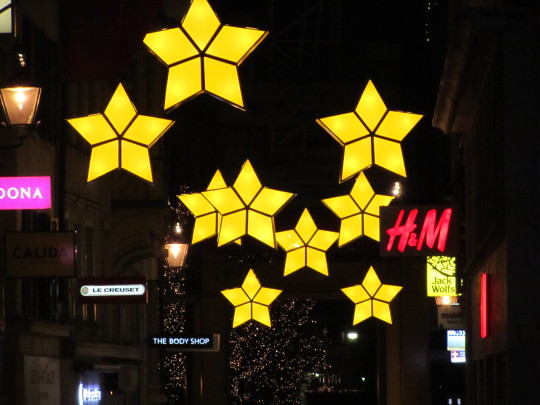


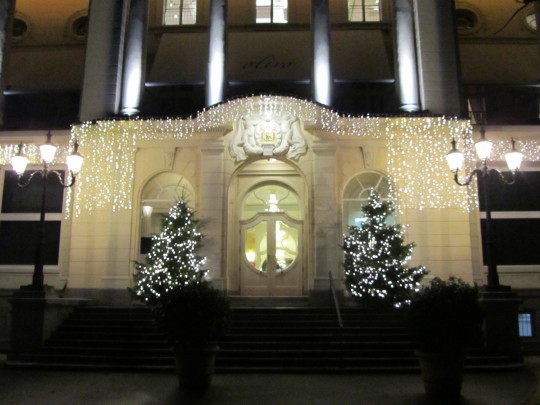








Boxing Day
The best way to celebrate the day is to take part in festivities in a country where Boxing Day is a bank holiday or public holiday. Watch some soccer, rugby, or cricket games, or go on a traditional fox hunt. If you can’t be in a country where these events are taking place, you could still get together with family and friends and eat leftovers from Christmas, or make some foods traditionally eaten on Boxing Day. You could also go shopping, as this is another important part of the day in many countries.
Boxing Day takes place the day after Christmas and is primarily observed in the United Kingdom, where it started, as well as in countries that were once part of the British crown. There are a few possible theories as to how it got started, but its exact origin is unclear.
One theory says it was inspired by Christmas boxes. In seventeenth-century Great Britain, boxes holding a present or gratuity were given to tradesman and workers in service industries for their previous year’s work. This went back to an even earlier tradition where servants would wait on and serve their rich masters on Christmas Day and would visit and celebrate with their own families on the day after Christmas. Their rich masters would sometimes give them a box with leftover food, a bonus, or another type of gift.
The day may have also stemmed from alms boxes that were put in Anglican churches on Christmas Day or during Advent and opened on the day after Christmas. These boxes collected money for the poor. Similarly, boxes were put outside of churches to collect money on Saint Stephen’s Day, which is held the day after Christmas. The events in the song “Good King Wenceslas” take place on Saint Stephen’s Day. The song recounts a story of King Wenceslas, a Bohemian king of the tenth century, bringing food and wine to a poor man. There is one other possible source for the beginning of the day. Ships once set sail containing a box of money for good luck. If the trip was a success, the box would be given to a priest, and he would open it on Christmas and give its contents to the poor.
Boxing Day has been a bank holiday in England, Wales, North Ireland, and Canada since 1871. It is celebrated in Australia, New Zealand, Trinidad and Tobago, and Nigeria. It is celebrated in Hong Kong, where the United Kingdom held sovereignty until 1997. In Ireland and in parts of Spain, it is known as Saint Stephen’s Day. It is celebrated as Second Christmas Day in some European countries, such as Poland, Hungary, Germany, Switzerland and the Netherlands; it is celebrated as such in Scandinavia as well. Boxing Day is generally not celebrated in the United States.
In some countries where it is celebrated as a bank holiday or public holiday, it is observed a day or two after December 26. If December 26 takes place on a Saturday, it may be observed the following Monday. If December 26 is on a Sunday, it may be observed on the following Tuesday. This is not always the case, however, as it is often observed on a Sunday if it falls on a Sunday.
Boxing Day is a day of the gathering of family and friends. Leftovers from Christmas are commonly eaten. Popular foods include baked ham, mince pies, Christmas cakes, and other desserts. In many countries of celebration, it is a shopping day similar to Black Friday. Sales take place and many retailers run them the whole week. Although, in some places, such as in parts of Canada, stores aren’t allowed to be open, in order to give families time to be together instead.
Sports are an important part of Boxing Day. In the United Kingdom, the top football (soccer) leagues of England, Scotland, and Northern Ireland play games. Lower leagues play games as well, and rugby leagues also hold matches. In various countries, events of other sports, such as cricket, horse racing, yacht racing, hockey, and boxing are often held to celebrate the day. Fun runs and swims in the cold English Channel take place. Fox hunting meets have been held for hundreds of years. A law passed in 2004, which went into effect the following year, banned the use of dogs to attack animals during hunts. But hunters have still used their dogs to chase artificial scents on the day, and have still gone on hunts where dogs are used to flush out foxes, but not to attack them.
Boxing Day, also known as Saint Stephen’s Day and Second Christmas Day, is being observed today! It has always been observed annually on December 26th.
Source
#Stephanstag#not for a long time#travel#Atlanta#Christmas in July#hotel lobby#Boxing Day#26 December#Georgia#Schweiz#Switzerland#Luzern#Lucerne#Lake Lucerne#Rigi#snow#River Reuss#old town#Christmas lights#night shot#landmark#tourist attraction#Saint Stephen’s Day#Second Christmas Day#holiday#BoxingDay#SaintStephensDay#Melchsee Frutt#Vierwaldstättersee#Obwalden
4 notes
·
View notes
Text
TIL that many high fashion design houses don't actually make any money from their clothes. They take a financial loss most of the time, in fact. The garments we see on the runways and later sold in their boutiques ARE the brand advertising, the thing that gets their brand names circulated, but they are not the true profit product. It's the handbags, shoes, and perfumes where they make all their profit.
Why? Because the profit margins on these products--the difference between how much they cost to produce vs. their retail price--is astronomical. Fashion industry insiders have admitted that, price-wise, elite designer shoes and handbags are the biggest scam in the entire clothing/accessories industry. Even with their European labor force making good wages factored in, these items still have roughly 3-5x the markup required to meet industry standard profit margins.
4 notes
·
View notes
Text

There’s a lot of research on banana production out there, especially from this great organisation called Bananalink which supports banana workers’ unions in the UK supply chain. Most the facts here are from these two pages on their website. I just wanted to ground some of the discussion around bananas in the production process, labour and environmental conditions, and who benefits from this process. The above diagram might not be very clear so I've reproduced the text below:
1. Banana production takes approximately nine months. It starts with the preparation of the soil including the clearing of land, drainage, installation and fertiliser application. Then planting and field work, such as weeding, pest and disease control, and irrigation, take place. Bananas are harvested while still green [you can watch a video of this process here]
2. The harvested bunches are transported to a packing shed where they are divided into smaller market-friendly bunches, inspected, sorted, washed, treated, labelled, and boxed for export. Bananas that do not meet the quality standard are usually sold locally at a much lower price or used for livestock feed.
3. Some bananas are pre-packed into bags according to the specifications of individual retailers. Pre-packing is used to differentiate bananas such as Fairtrade organics or small bananas from the bulk supply of loose bananas. It can be an opportunity for the grower to add value, but it also offers advantages in controlling quality and reducing wastage.
4. Bannas are then transported by truck to ports, placed in sheds, and packed in refrigerated ships or refridgerated containers. Bananas take between six to 12 days to get to the UK/Europe. They are shipped at a controlled temperature of 13.3 centigrade in order to increase their shelf life. Humidity and ventilation are carefully monitored to maintain quality.
5. When the bananas arrive at their destinaation port they are first trucked to warehouses where they can be kept in cool conditions and then ripened - using ethylene - when they are needed for delivery to retailers. Bananas may also be bagged at this stage. They are then delivered to retailers' regional distribution centres before final delivery to individual stores.
The local population eat different varieties of bananas grown primarily by small farmers. The ones for the Americans and the Europeans, Cavendish variety bananas, are grown in huge, monoculture plantations that are susceptible to disease. The banana industry consumes more agrichemicals than any other in the world, asides from cotton. Most plantations will spend more on pesticides than on wages. Pesticides are sprayed by plane, 85% of which does not land on the bananas and instead lands on the homes of workers in the surrounding area and seeps into the groundwater. The results are cancers, stillbirths, and dead rivers.
The supermarkets dominate the banana trade and force the price of bananas down. Plantations resolve this issue by intensifying and degrading working conditions. Banana workers will work for up to 14 hours a day in tropical heat, without overtime pay, for 6 days a week. Their wages will not cover their cost of housing, food, and education for their children. On most plantations independent trade unions are, of course, suppressed. Contracts are insecure, or workers are hired through intermediaries, and troublemakers are not invited back.
Who benefits most from this arrangement? The export value of bananas is worth $8bn - the retail value of these bananas is worth $25bn. Here's a breakdown of who gets what from the sale of banana in the EU.
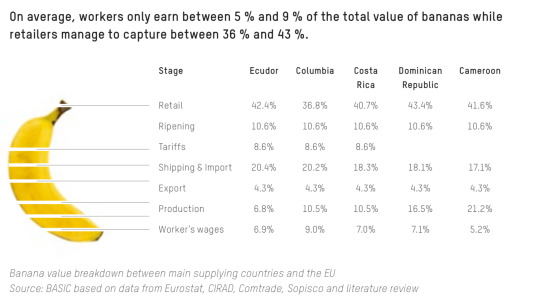
On average, the banana workers get between 5 and 9% of the total value, while the retailers capture between 36 to 43% of the value. So if you got a bunch of bananas at Tesco (the majority of UK bananas come from Costa Rica) for 95p, 6.65p would go to the banana workers, and 38p would go to Tesco.
Furthermore, when it comes to calculating a country's GDP (the total sum of the value of economic activity going on in a country, which is used to measure how rich or poor a country is, how fast its economy is 'growing' and therefore how valuable their currency is on the world market, how valuable its government bonds, its claim on resources internationally…etc), the worker wages, production, export numbers count towards the country producing the banana, while retail, ripening, tariffs, and shipping & import will count towards the importing country. A country like Costa Rica will participate has to participate in this arrangement as it needs ‘hard’ (i.e. Western) currencies in order to import essential commodities on the world market.
So for the example above of a bunch of Costa Rican bananas sold in a UK supermarket, 20.7p will be added to Costa Rica’s GDP while 74.3p will be added to the UK’s GDP. Therefore, the consumption of a banana in the UK will add more to the UK’s wealth than growing it will to Costa Rica’s. The same holds for Bangladeshi t-shirts, iPhones assembled in China, chocolate made with cocoa from Ghana…it’s the heart of how the capitalism of the ‘developed’ economy functions. Never ending consumption to fuel the appearance of wealth, fuelled by the exploitation of both land and people in the global south.
25 notes
·
View notes
Text
Under the leadership of Turkey’s founder, Mustafa Kemal Atatürk, the republic allowed for the unfettered production of opium, morphine, and heroin through the 1920s. League of Nations member states raged against Turkey’s intransigence, arguing that the country was responsible for selling up to 480 tons of illicit opium annually between 1925 and 1930.
[...]
Kurdish and European-based drug trafficking syndicates appear to have persisted in their importance and vitality in the three decades following the 1980 coup. Rising heroin usage in major European cities, as well as publicity drawn from several notorious criminal cases, shed a larger international spotlight upon the strength and invasiveness of Turkish-led heroin networks.
European and American inquiries into the 1981 attempted assassination of Pope John Paul II led to wide-ranging discussions of the criminal history and associates of Mehmet Ali Ağca, the pope’s would-be assassin. Ağca’s relationship with drug traffickers in Bulgaria led to a small stream of official and journalistic investigations into the links forged between Turkish smugglers and members of Italy’s various crime groups.
Later, with the fall of the Iron Curtain, European authorities observed the growing influence of Turkish nationals in regional distribution networks, including street dealing. Still other cases, such as the 1992 apprehension of Hüseyin Baybaşin, a PKK-linked heroin smuggler, affirmed Ankara’s position that heroin smuggling had become an industry dominated by Kurdish militants.
With the escalation of the PKK’s armed campaign against the Turkish state after 1984, Turkish officials maintained that 90 percent of the cases brought against drug smugglers in the country involved PKK sponsorship. Even after the 1998 apprehension of the PKK leader, Abdullah Öçalan, Turkish officials continued to assert that Kurdish militants were engaged at all levels of the heroin trade, be it production, taxing, smuggling, or retailing the drug in European cities.
-- The Oxford Handbook of Global Drug History
4 notes
·
View notes
Text
This day in history
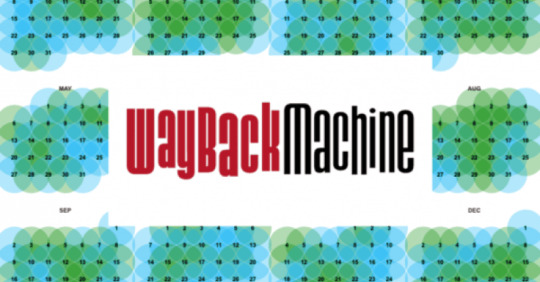
#20yrsago Category Management: retail trendiness or criminal anti-trust? https://web.archive.org/web/20030207054524/http://www.business2.com/articles/mag/print/0,1643,46334,00.html
#20yrsago Finnish recording industry demands royalties for kindergarten singing https://web.archive.org/web/20030207180706/http://www.infoanarchy.org/story/2003/1/29/02755/7928
#15yrsago Tipping-point skeptic says that super-Influencers are overrated https://www.fastcompany.com/641124/tipping-point-toast
#15yrsago SFWA European Hall of Fame: a chance to read sf from outside of the Anglo Bubble https://memex.craphound.com/2008/01/28/sfwa-european-hall-of-fame-a-chance-to-read-sf-from-outside-of-the-anglo-bubble/
#10yrsago Jonathan Coulton responds to Fox/Glee’s plagiarism of his song by “covering” it and making rival version available for sale https://web.archive.org/web/20130122033150/https://kotaku.com/jonathan-coulton
#10yrsago Aaron Swartz’s San Francisco memorial will make you stand up and salute https://archive.org/details/AaronSwartzMemorialAtTheInternetArchive
#5yrsago New York Times profiles a sleazy Twitter follower-farm, the sleazy serial liar who made millions on it, and the celebs, politicians, sports figures and “influencers” who paid him https://www.nytimes.com/interactive/2018/01/27/technology/social-media-bots.html
#5yrsago One quarter of New Orleans’ catch-basins were clogged to uselessness with 93,000 lbs of plastic Mardi Gras beads https://www.nola.com/news/politics/46-tons-of-mardi-gras-beads-found-in-clogged-catch-basins/article_37e0ff53-894c-5aed-b4c3-129852582269.html
#5yrsago A 1×1 tracking pixel was used as evidence of treason against 30,000 Turks, sent tens of thousands to jail https://www.cbc.ca/news/world/terrifying-how-a-single-line-of-computer-code-put-thousands-of-innocent-turks-in-jail-1.4495021
#5yrsago Academic audit of HUD budget finds $351 million in unaccounted-for spending since 1998 https://msutoday.msu.edu/news/2017/msu-scholars-find-21-trillion-in-unauthorized-government-spending-defense-department-to-conduct
#5yrsago Majority of Democrats now hold favorable views of mass-murdering simpleton George W Bush https://news.libertasbella.com/story/libertas-bella-news-acquires-the-anti-media/
#5yrsago Scott Walker is terrified that Democrats will win special elections to fill vacant seats, so he’s leaving thousands of Wisconsinites without state reps https://web.archive.org/web/20180901000000*/https://www.thenation.com/article/scott-walker-is-literally-preventing-wisconsinites-from-voting/
#1yrago California’s chance for universal health care https://pluralistic.net/2022/01/28/american-exceptionalism/#ab-1400
3 notes
·
View notes